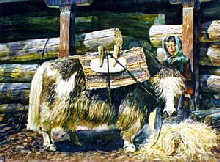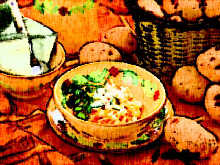An artist's favorite

Artists have favored watercolors for their luminous transparency since medieval times when they were widely used to illuminate manuscripts. Modern watercolors are a complex mix of pigments and ingredients that glide smoothly over paper when mixed with water; and since they are water-soluble, they are relatively easy to clean.
Due to their light effects, many famous modern artists often choose watercolors as the preferred medium when traveling or exploring the great outdoors. But modern watercolorists don't just paint landscapes and cityscapes: As many American painters have discovered, the subtle light effects achieved with watercolors can help capture the nuances of abstract and still-life compositions.
Watercolors are perhaps the most efficiently portable medium: Each tiny tube or dried cake (called a pan) of watercolors packs a surprising large quantity of rich, vibrant colors. Watercolor artists don't need canvases or wooden panels, either: They usually paint on special paper made from linen rags.
Development in China
The 1930s was an extraordinary period in China that produced many schools of thought and many outstanding scholars and talents. It was during this period that the first climax of Chinese watercolor paintings took shape.
Watercolor painting, which originated in Europe in the 15th century, developed into an independent branch of painting in the 18th century in England. It is still a popular art form in the West today. Most Chinese artists who studied art in Europe and Japan in the 1930s were also proficient in watercolors. Lin Fengmian, Pang Xunqin and Liu Jintang were among the most renowned masters of the time. Most painters of the period were not only skillful artists, but also scholars with a broad vision, engaging in high pursuits. Even today, their works are still considered very inspirational.

The 1950s witnessed the second climax of watercolor painting in China, centering in Shanghai. Fan Mingti, Li Ximing, Sheng Roujian, Zhang Chongren, Li Jianchen and many others were all famous for their watercolor works.
The third wave of watercolor painting occurred in the 1980s. During this period, with numerous watercolor painters and frequent watercolor painting exhibitions, a national watercolor painters association was founded. During this period, watercolor painting reached unprecedented popularity and success.










